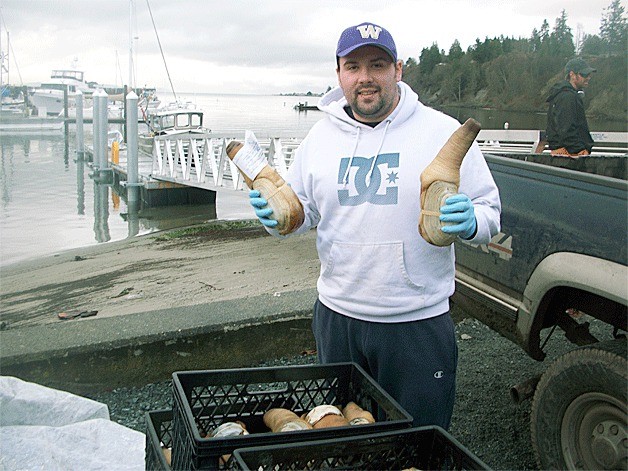The geoduck (pronounced gooey-duck) has a funny name and its appearance often elicits embarrassed laughter, but Washington’s biggest clam means big money to the Department of Natural Resources and fine eating, particularly for wealthy devotees in China.
For the first time in years, commercial geoduck harvesting is under way in Langley. It started Monday, Jan. 7 and ended Friday.
The DNR manages two geoduck fishery tracts near Langley. Langley North is 129 acres in size and Langley South is 54 acres. Other Island County tracts are listed as Admiralty Bay, Austin, Cultus Bay, Dines Point, Double Bluff, Holmes Harbor, Lagoon Point, Point Partridge, Randall, Rocky Point and Useless Bay.
Adam Peterson, truck driver for Alaska Ice Seafoods, stopped by the Langley Marina last week to pick up plastic crates loaded with geoducks from that day’s harvest. The clams average two to three pounds each and cost approximately $14 a pound for the harvester. “The whiter they are the better,” he said.
Ralph Downes, a game agent who has covered Whidbey Island for the Department of Fish and Wildlife for the past 22 years, said four bid winners were awarded the opportunity to work the Langley tracts, with quotas of 8,017 pounds each, bringing the total allowed harvest to 36,068 pounds.
Harvesters, including Alaska Ice, International Shellfish and Global Pacific Seafood, bid from $8.09 to $8.79 per pound. The state adds a fee of $4.50 for each pound harvested bringing the cost to between $12.59 and $13.29. The harvest cost itself is estimated at $2 per pound, jumping the total cost to $14.86 per pound.
The harvest cost may seem high, but retail prices more than make up for it. Downes said portions of top quality geoduck can bring $100 to $150 a pound in the international marketplace. Geoducks are considered a delicacy in China.
“Not bad for a clam that a decade ago was sold for a fraction of the price and destined to be canned as chopped clams,” Downes said. Although the DNR manages the geoduck harvest, the Department of Wildlife’s job is to keep poachers away. “Any time there is this much profit to be made, the criminal element won’t be far behind,” he said.
The harvesters are themselves closely observed. The DNR has a boat on scene to monitor the harvest and puts divers under water to make sure the commercial divers aren’t picking and choosing from among the geoducks, selecting the whiter specimens only.
Geoducks are notoriously hard to gather for recreational enthusiasts digging them at extreme low tides in the spring and summer. They live up to 3 feet under the sand. But commercial harvesters use water pressure. “They blast ’em out with water pressure from the harvest vessel to blow the substrate away until the clam is free,” is how Downes describes the process.
Homeowners on the bluffs about Langley haven’t seen a commercial geoduck harvest in years.
Downes likened the geoduck crop to timber harvest.
It takes a couple of decades for small geoducks to grow large enough to harvest, so once this year’s Langley harvest is finished, harvesters won’t be back for years.
The DNR geoduck harvest started small in 1970 when 82,000 pounds were collected with a value of $13,000 at the dock. By 2010, the figures had skyrocketed to 4.43 million pounds with a value of $36.1 million.
According to the DNR website, the geoduck harvest is managed for sustainability. The harvest rate is 2.7 percent of current stock estimates and is based on such biological parameters as geoduck natural mortality, growth and maturity. Beds are surveyed before and after harvest to corroborate harvest reports and establish a “post-fishing biomass estimate.”
Geoducks live a long time, up to 160 years for one sample taken in Washington. The DNR estimates the average age for geoducks on unfished beds is 46 years old.
“The two tracts in Langley haven’t been harvested in many a moon,” Downes said. And it will be many a moon before the harvesters return.



